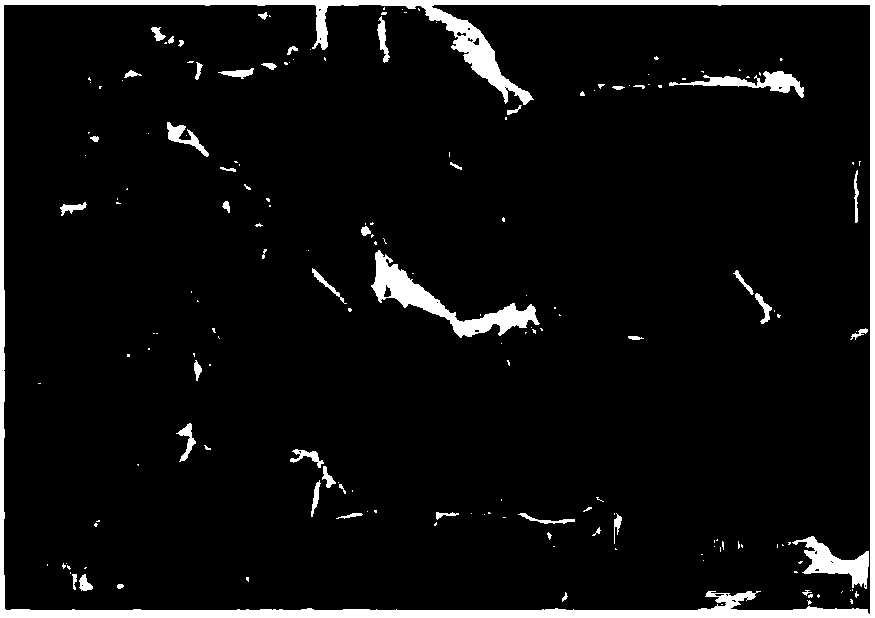A kind of preparation method of sodium ion battery negative electrode carbon material containing multi-level pore size distribution
A sodium-ion battery, pore size distribution technology, applied in battery electrodes, secondary batteries, circuits, etc., can solve the problems of unfavorable electrolyte penetration, complex preparation process, etc., and achieve the effect of improving pseudocapacitive capacity and enhancing adsorption capacity
- Summary
- Abstract
- Description
- Claims
- Application Information
AI Technical Summary
Problems solved by technology
Method used
Image
Examples
Embodiment 1
[0033] (1) The dandelion collected is cleaned, dried, and sealed for preservation;
[0034] (2) Weigh 2.0 g of washed dandelion with a balance, put it in a beaker, then add phosphoric acid with a mass fraction of 85%, and the mass ratio of phosphoric acid and dandelion is 1:1, heat in a vacuum oven at 60°C for 24 hours , to obtain product A.
[0035] (3) NaClO 4 、Na 2 CO 3 , NaH 2 PO 4 Mix evenly with a mass ratio of 1:1:0.6 to obtain product B;
[0036] (4) Mix product A and product B at a mass ratio of 1:1, grind in a mortar for 30 minutes, and then add 40 mL of water to dissolve to obtain product C;
[0037] (4) heating product C in a vacuum oven at 60°C for 24 hours to obtain product D;
[0038] (5) Place the product D in a white porcelain boat, place it in a tube furnace for calcination, under the protection of argon, and the flow rate of the argon gas flow is 0.5 sccm·min -1 , at 5°C·min -1 The heating rate is increased to a calcination temperature of 500°C, and...
Embodiment 2
[0041] (1) The dandelion collected is cleaned, dried, and sealed for preservation;
[0042](2) Take 2.0 g of washed dandelions with a balance, place them in a beaker, then add phosphoric acid with a mass fraction of 85%, the mass ratio of phosphoric acid and dandelions is 2:1, and heat in a vacuum oven at 60°C for 24 hours, Product A is obtained.
[0043] (3) NaClO 4 、Na 2 CO 3 , NaH 2 PO 4 Mix evenly with a mass ratio of 1:1.2:0.8 to obtain product B;
[0044] (4) After mixing product A and product B at a mass ratio of 5:1, grind them in a mortar for 30 minutes, then add 30 mL of water to dissolve to obtain product C;
[0045] (5) heating product C in a vacuum oven at 50°C for 24 hours to obtain product D;
[0046] (6) Place the product D in a white porcelain boat, place it in a tube furnace for calcination, under the protection of argon, and the flow rate of the argon gas flow is 0.2 sccm·min -1 , at 2°C·min -1 The heating rate was increased to a calcination tempera...
Embodiment 3
[0051] (1) The dandelion collected is cleaned, dried, and sealed for preservation;
[0052] (2) Weigh 2.0 g of washed dandelion with a balance, place it in a beaker, then add phosphoric acid with a mass fraction of 85%, and the mass ratio of phosphoric acid and dandelion is 3:1, heat in a vacuum oven at 80°C for 24 hours , to obtain product A.
[0053] (3) NaClO 4 、Na 2 CO 3 , NaH 2 PO 4 Mix evenly with a mass ratio of 1:1.5:0.6 to obtain product B;
[0054] (4) After mixing product A and product B at a mass ratio of 6:1, grind them in a mortar for 30 minutes, then add 20 mL of water to dissolve to obtain product C;
[0055] (5) heating product C in a vacuum oven at 30°C for 24 hours to obtain product D;
[0056] (6) Place the product D in a white porcelain boat, place it in a tube furnace for calcination, under the protection of argon, and the flow rate of the argon gas flow is 0.1 sccm·min -1 , at 4°C·min -1 The heating rate is increased to a calcination temperature...
PUM
 Login to View More
Login to View More Abstract
Description
Claims
Application Information
 Login to View More
Login to View More - R&D
- Intellectual Property
- Life Sciences
- Materials
- Tech Scout
- Unparalleled Data Quality
- Higher Quality Content
- 60% Fewer Hallucinations
Browse by: Latest US Patents, China's latest patents, Technical Efficacy Thesaurus, Application Domain, Technology Topic, Popular Technical Reports.
© 2025 PatSnap. All rights reserved.Legal|Privacy policy|Modern Slavery Act Transparency Statement|Sitemap|About US| Contact US: help@patsnap.com



